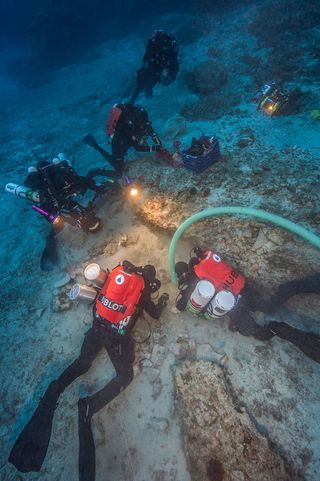Antikythera Wreck Yields More Treasures of Ancient Greece's '1 Percent'

A bronze chair arm — possibly the remains of an ancient throne — and a piece of a Greek board game are among the latest treasures raised from the site of the famous shipwreck Antikythera.
The ship, which went down in 65 B.C., sits off the coast of the Greek island of the same name. It was discovered in 1900 by sponge fishermen and has been periodically studied since.
This year, archaeologists discovered an intact amphora (a vaselike container), a small table jug (known as a lagynos) and a rectangular chiseled stone, probably a statuette base. Digging on the seafloor, they found broken ceramics, a piece of a bone flute, and broken bits of glass, iron and bronze. A section of bronze furniture may be the arm of a throne, according to the Woods Hold Oceanographic Institution (WHOI). A small glass piece looks to be a pawn in a chesslike game. [See Photos of the Ancient Antikythera Shipwreck and Treasure]
"This shipwreck is far from exhausted," project co-director Brendan Foley, a marine archaeologist at WHOI, said in a statement. "Every single dive on it delivers fabulous finds, and reveals how the '1 percent' lived in the time of Caesar."
Rediscovery
The first sponge diver to explore the wreck in 1900, Ilias Stadiatis, managed to bring a bronze arm from a statue up 164 feet (50 meters) to the surface. The Greek government quickly sent naval support to the area, and divers brought up 36 marble statues of heroes and gods, along with other luxury items and skeletons belonging to the crew and passengers. In 1901, the divers brought up an incredible astronomical calendar, the Antikythera mechanism, which could determine the positions of heavenly bodies like Mercury, Venus and Mars. It remains the most complex ancient item ever found, according to the Hellenic Ministry of Culture and Sports.

The ministry and the WHOI are currently involved in a long-term project at the site. In 2014, archaeologists conducted the first modern scientific excavation of the wreck, creating a three-dimensional map of the site. But little time was spent in the depths with the wreck because of bad weather.
Sign up for the Live Science daily newsletter now
Get the world’s most fascinating discoveries delivered straight to your inbox.
This year, archaeologists were able to spend 40 hours diving amid the wreckage. Along with the cargo they discovered, the researchers also found a lead salvage ring and two lead anchor stocks, lead hull sheathing and nails and wood from the ship itself.
"We were very lucky this year, as we excavated many finds within their context, which gave us the opportunity to take full advantage of all the archaeological information they could provide," diving archaeologist Theotokis Theodoulou, of the Hellenic Ministry of Culture and Sports, said in the WHOI statement.
Artifact bonanza
The archaeologists used last year's 3D map as a guide; a remotely operated vehicle recorded their dives and enabled communications with the surface.
A metal detector survey revealed metal objects scattered over an area of 131 feet by 164 feet (40 meters by 50 meters), reflecting the huge size of the ship. The researchers used a submersible dredge and pump to dig nine trenches in this area, bringing more than 50 new artifacts to the surface.
Researchers are now studying these objects, subjecting the contents of the ceramic jars to DNA analysis to find out what kind of food, drink or perfumes are inside. They also plan to analyze the lead objects to learn where the lead was mined.
Follow Stephanie Pappas on Twitter and Google+. Follow us @livescience, Facebook & Google+. Original article on Live Science.

Stephanie Pappas is a contributing writer for Live Science, covering topics ranging from geoscience to archaeology to the human brain and behavior. She was previously a senior writer for Live Science but is now a freelancer based in Denver, Colorado, and regularly contributes to Scientific American and The Monitor, the monthly magazine of the American Psychological Association. Stephanie received a bachelor's degree in psychology from the University of South Carolina and a graduate certificate in science communication from the University of California, Santa Cruz.
Most Popular

